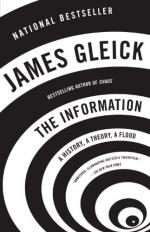
|
| Name: _________________________ | Period: ___________________ |
This test consists of 15 multiple choice questions and 5 short answer questions.
Multiple Choice Questions
1. What were the benefits of the early logarithm tables?
(a) Cut down on errors and allowed for quicker calculations.
(b) Eliminated calculations.
(c) Provided solutions.
(d) Made work easier.
2. What did Alan Turing reduce human thought to?
(a) Its basic elements.
(b) 0s and 1s.
(c) Symbols.
(d) Numbers.
3. What were conflicting statements created by the Principia Mathematica called?
(a) Circular arguments.
(b) Recursive.
(c) Non-conclusive results.
(d) False positives.
4. What was changing language at the time the first English dictionary was developed?
(a) Increased population.
(b) Advanced education.
(c) International trade.
(d) Travel and conquest.
5. What type of lists did Babbage create about livestock, fabric, letter combinations in various languages and other facts?
(a) Alphabetical.
(b) Statistical.
(c) Numeric.
(d) Random.
6. Claude Shannon and Alan Turing were working on separate cryptography project and shared what astounding possibility?
(a) That machines could think.
(b) That machines could cure disease.
(c) That machines could take over the human race.
(d) That machines could have emotions.
7. How was the machine created by Charles Babbage received?
(a) It was very well received in academia.
(b) It failed to receive governmental backing.
(c) It received government backing but was not considered practical.
(d) It was very well received in the mathematics community.
8. How did people save money in sending telegraph messages?
(a) By creating their own code.
(b) By compressing the message.
(c) By not using it.
(d) By bribing the operators.
9. What was Shannon able to theoretically compute by measuring a message in bits? By measuring information in bits, he could theoretically compute the maximum amount of information that could be transmitted through a given channel.
(a) The virtual size of the message in microns.
(b) The limits of computing.
(c) The maximum amount of information that could be transmitted.
(d) The maximum size a message could be.
10. What was the intent of the Principia Mathematica?
(a) To prove or disprove any statement.
(b) To disprove the theory of relativity.
(c) To prove or disprove quantum consciousness.
(d) To confirm the theory of gravity.
11. An alphabetical list did not take what element of the word into account at all, but mechanically placed it in a slot based on the order of the letters?
(a) Its importance.
(b) Its relevance.
(c) Its meaning.
(d) Its popularity.
12. Shannon showed that it was theoretically possible to overcome any amount of signal noise by what action?
(a) By limiting data.
(b) By sending corrective bits of information.
(c) By creating the first anti-virus element.
(d) By changing locations.
13. How was "A Table Alphabeticall" intended to help people?
(a) To understand the alphabets of the world.
(b) To learn the history of language.
(c) The learn the alphabet.
(d) To better understand the use of words.
14. Where was knowledge stored prior to the written word?
(a) In tribal strongholds.
(b) By legend.
(c) In the mind.
(d) Word of wise men.
15. in what year did John Carrington, an English missionary, publish "The Talking Drums of Africa"?
(a) 1972
(b) 1845
(c) 1902
(d) 1949
Short Answer Questions
1. How did the telegraph advance weather forecasting?
2. How were telegraph messages priced?
3. Who was the sixth editor of the Oxford English Dictionary?
4. How were phonetic sounds represented in language?
5. Who invented the telegraph?
|
This section contains 561 words (approx. 2 pages at 300 words per page) |

|




